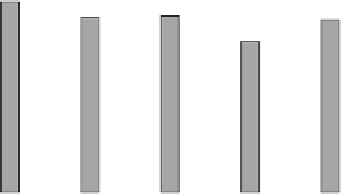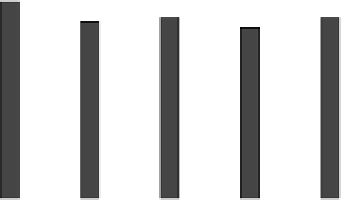Environmental Engineering Reference
In-Depth Information
70
60
50
40
30
20
10
0
1997
1998
1999
2000
Mean
Maximum
deviation
Standard
deviation
Measured consumption
G15 correction
G15 plus irradiance correction
Figure 6.33
Heating energy consumption measured and corrected by degree days and solar gains
A year with very low solar gains therefore has a low contribution to the degree-day-
corrected sum of consumption plus gains. After subtraction of the standard gains the
normalized consumption value is lower. Conversely, a year with very high solar gains
results in a higher corrected heating energy consumption. The improvement in the
normalized value using the different corrections is shown in Figure 6.33. The standard
deviation is slightly reduced, but the effect is not very significant.
For a higher time resolution in the simulation, for example a daily basis, the heat-
ing and cooling energy algorithms of DIN V 18599 have been implemented in the
simulation environment INSEL. Daily heating energy demand can be calculated from
the building's energy balance for transmission and ventilation losses and heat gains
from solar irradiance and internal loads. The building's storage mass influences the
efficiency
η
, which determines the useful heat gains for that day from the ratio of gains
to losses. However, stored energy cannot be transferred from one day to the next, as
the ratio of gains to losses is calculated anew each day.
Although the error between the measured and simulated monthly energy consump-
tion is only 5%, the daily errors are significant (see Figure 6.34). This is partly due
to constant air change rates and internal loads for every day, so that weekend days
are often overestimated in the calculation, but also partly due to the missing dynamic
storage.
From the measured data, it can be seen that for a given ambient temperature large
fluctuations of daily heating energy consumption occur (see Figure 6.35). This can
be mainly attributed to the occupancy and user behaviour: for example, consumption
drops strongly at weekends independent of ambient temperature (see Figure 6.36).











Search WWH ::

Custom Search